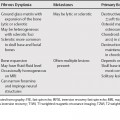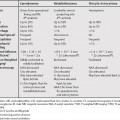139 There are numerous variants in the anterior-superior labrum. Variants such as the Buford complex (absent anterior-superior labrum and hypertrophied middle glenohumeral ligament) and sublabral foramen can usually be differentiated from superior labral anterior to posterior (SLAP) tears as these variants occur anterior (in the 1 to 3 o’clock position) to the typical location of SLAP tears. SLAP tears are often difficult to differentiate from a normal variant sublabral recess. These are both seen at the 11 to 1 o’clock position of the glenoid labrum in the region of the biceps anchor. The type II tears (stripping of the superior labrum and attached biceps tendon from the glenoid cartilage) are the most common and also the most easily confused with a sublabral recess. Although in some cases, there is an overlap in appearance and these entities cannot be distinguished, the following findings are usually seen in SLAP tears rather than in a sublabral recess.1,2
Superior Labral Anterior-Posterior Tear versus Sublabral Recess
Features of SLAP Tears
Stay updated, free articles. Join our Telegram channel

Full access? Get Clinical Tree





